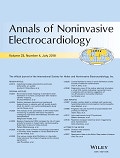Chest-lead STJ amplitudes using arm electrodes as Reference instead of the Wilson central terminal in smartphone ECG applications: Influence on ST-elevation myocardial infarction criteria fulfillment

Background
“Smartphone 12-lead ECG” for the assessment of acute myocardial ischemia has recently been introduced. In the smartphone 12-lead ECG either the right or the left arm can be used as reference for the chest electrodes instead of the Wilson central terminal. These leads are labeled “CR leads” or “CL leads.” We aimed to compare chest-lead ST-J amplitudes, using either CR or CL leads, to those present in the conventional 12-lead ECG, and to determine sensitivity and specificity for the diagnosis of STEMI for CR and CL leads.Methods
Five hundred patients (74 patients with ST elevation myocardial infarction (STEMI), 66 patients with nonischemic ST deviation and 360 controls) were included. Smartphone 12-lead ECG chest-lead ST-J amplitudes were calculated for both CR and CL leads.Results
ST-J amplitudes were 9.1 ± 29 μV larger for CR leads and 7.7 ± 42 μV larger for CL leads than for conventional chest leads (V leads). Sensitivity and specificity were 94% and 95% for CR leads and 81% and 97% for CL leads when fulfillment of STEMI criteria in V leads was used as reference. In ischemic patients who met STEMI criteria in V leads, but not in limb leads, STEMI criteria were met with CR or CL leads in 91%.Conclusion
By the use of CR or CL leads, smartphone 12-lead ECG results in slightly lower sensitivity in STEMI detection. Therefore, the adjustment of STEMI criteria may be needed before application in clinical practice.
Thomas Lindow, Henrik Engblom, Ardavan Khoshnood, Ulf Ekelund, Marcus Carlsson, Olle Pahlm
2018
Annals of Noninvasive Electrocardiology, 23(5):e12549
